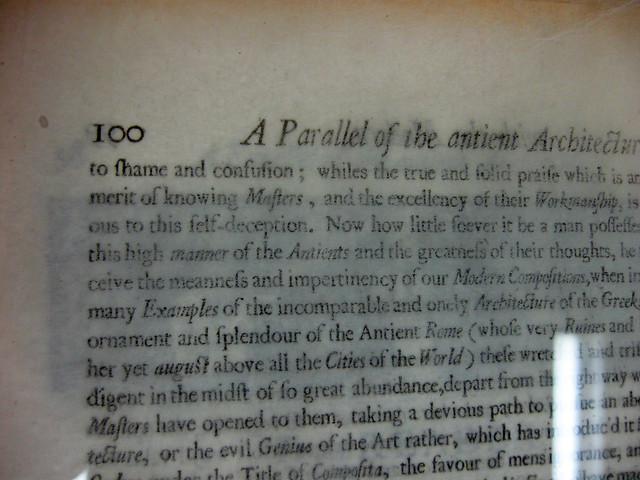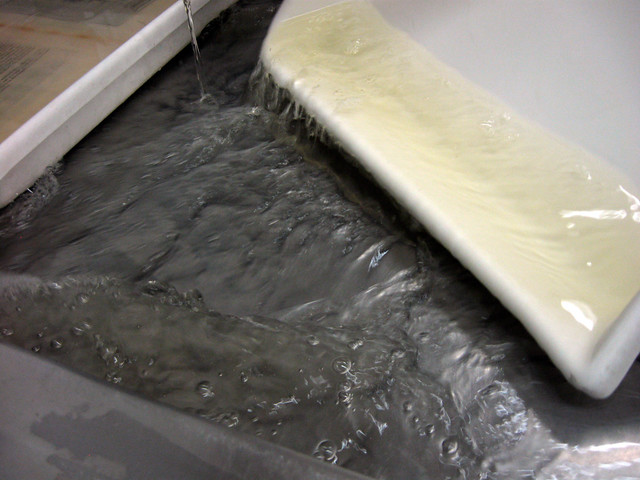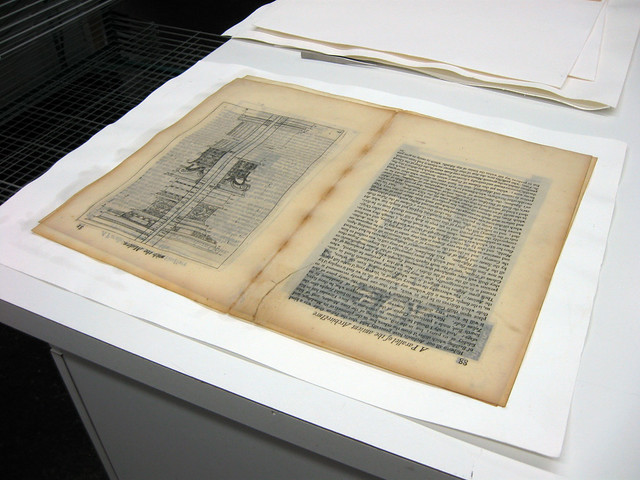Some time in August, my co-worker in the library's conservation lab told me she was going to wash a book and asked if I was interested in watching. My jaw promptly fell off, indicating that yes, I was interested in that. I waited and waited and waited, and finally the day came: the day of the washing of the book. I cannot express how excited I was.
Book washing is both complicated and simple. Basically, you unbind a book, put the pages in a solution, let them sit, air-dry them, press-dry them, and re-bind them. But obviously there's more to it than that. My conservator friend said a lot of things about chemistry that went over my head, for example. The solution she used in this case was, I think, just ethyl alcohol, but sometimes it's more complicated than that. It has to do with what's in the paper and what's on the paper. Some inks do not agree with some chemicals, and terrible things can happen.
Nothing terrible happened to this book. It had very sturdy pages because its paper was made of rags. I learned a lot about paper-making, including the delightful fact that paper-making used to seriously injure and sometimes kill people. Paper used to be made by putting a kind of mesh screen in a vat of rag pulp and lifting it directly up so that the screen remained horizontal. As you can imagine, this would strain even very powerful shoulders after a while, and I was told that sometimes people would just pop. They'd give out. Their arms would just be destroyed. Sometimes the pressure it put on their muscles would kill them. Paper-making was serious business.
Rather remarkably, rag paper withstands water extremely well, and ink usually does, too. I was surprised how rough our conservator could be with them without harming them at all. Which is not to say that she wasn't extremely careful -- but she wasn't moving at a snail's pace and biting her lips like I would have been. The paper was practically as sturdy as cloth, although it would tear quite easily if you went with the grain.
 |
| Check out those ligatures! omg! |
But the paper does bond with itself and is difficult to separate if it touches in the water, so it's necessary to put a piece of this special kind of paper in between:
I wish I could be more specific than "special kind of paper," but it's very difficult to take photos and notes at the same time! This is what makes the ink in the above two images look gauzy and dreamlike - it's very thin and transparent when wet, but is enough to prevent the pages from bonding.
The book pages sit in these shallow vats for a while, making the water a yucky shade of yellow.
This book wasn't all that disgusting, but since the alcohol can be reused, you can see how dirty other pages have been.
When the pages have soaked long enough, they are laid flat on these absorbent sheets (which are also reused) and set in a drying rack. After this, they are dried in a press, but that's a delicate process. If you put too much pressure on the paper, you can lose things like the indent into the paper where you can see the edge of the printer's block. Which is the kind of thing that's terrifying and one reason I don't allow myself to be around precious objects. O the responsibility!
Once the pages are dry, they can either go back in their original binding (if it's in good condition or unique or important in some way) or into a new binding (if the old binding is not original, full of damaging acid, or too decrepit to save). I've seen some pretty incredible bindings in the conservation lab, including one our conservator did of a sixteenth-century book (if I'm recalling correctly) -- re-bound in snow-white pigskin.
It's pretty cool that we have a conservation lab in our library, and even cooler that our conservationist is so happy to talk about her work with fascinating underlings. She even puts up with me gasping and clutching my chest every time I learn a new and interesting fact, which is every two seconds. Next time I'll take better notes so that you can become as ridiculous as I am.







2 comments:
Fascinating! I understand that f is really s, but when f is also f it is really confusing and reading is more like translating.
Agreed. Once I had to read a book for college that was only available in an edition that had those crazy s's. It took me twice as long to read it because I kept getting confused. Also, when I was done I had the distinct impression that the author had had a lisp.
Post a Comment